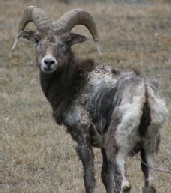| Psoroptic
Mange in California Bighorn Sheep |
|
| |
| Causative Agent |
-
Psoroptes ovis
is a
non-burrowing
ectoparasitic
mite
belonging to the family Psorptidae (Order: Acarina)
-
It
is the cause of psoroptic mange, also referred to as “sheep scab”,
psoroptic scabies or Psoroptes infestation,
a
highly contagious and devastating condition that can affect domestic
and wild sheep.
-
Psoroptic mange has been the cause of significant economic loss in
domestic sheep farms due to reduced condition and damage to the
fleece in infested animals, and, accordingly, has been listed as an
annually notifiable disease by the Canadian Food Inspection Agency
(CFIA) under the Health of Animals Act.
|
| Images |
|
Click on
image to
enlarge. |
 |
|
Ram affected with psoroptic
mange from Olalla, British Columbia. |
|
| Distribution |
|
Geographic: |
-
Psoroptic mange is a newly recognized
health issue of wild
sheep in the Similkameen Valley of southern BC.
-
Despite occurring worldwide,
Psoroptes
mites
are considered uncommon in
domestic sheep and cattle as they are easily controlled with
injectable pharmaceuticals.
-
Because it is so easily
controlled, psoroptic mange was eradicated from Canadian
domestic sheep in 1924.
-
While it is still present to
varying degrees in some populations of bighorn sheep in the
US, it has never before been reported in Canada prior to
February 2011.
|
|
Seasonality: |
-
Mite populations are generally lower in the spring
and summer, with increases in the fall/winter.
|
|
| Hosts, Transmission and Life
Cycle |
| Hosts: |
-
In BC, California Bighorn Sheep (Ovis canadensis).
|
|
Transmission: |
-
Transmission is typically through direct contact
with infested individuals, making psoroptic mange a herd
disease; it only takes a single gravid female
mite to
establish an infestation on an individual and, hence, the
entire herd.
-
Fomites, such as contaminated fence posts, feeders,
or chutes, are sources of infection in domestic animals, and
similar contaminated objects in nature may play a role in
transmission and maintenance of the
mite
among and within bighorn sheep populations.
|
|
Life Cycle: |
-
Psoroptes ovis
is
an obligate
ectoparasite -
its entire life cycle occurs on a single host.
-
As
mites
abrade the skin and incite a potent
inflammatory response, the subsequent
exudate and crust that forms provides a perfect
environment for mites to thrive and reproduce in.
-
A
single female mite can deposit anywhere between 35-100 eggs
in her adult lifetime, which is approximately 30-60 days.
-
Once
hatched,
mites
proceed through one larval stage and two nymphal stages before
finally molting into their adult form.
-
This
entire lifecycle, from egg to egg, takes approximately two
weeks, but may vary with environmental conditions.
|
|
| Signs and Symptoms |
-
In some locations and in some animals, a severe disease occurs where
animals develop heavy crusts in and around their ears and over their
bodies, lose hair and body condition, and subsequently may die.
-
The disease is considered an animal welfare issue due to the intense pain
and irritation caused by the
mites.
-
Signs in individual sheep may include:
-
yellowish, scaly crusts
are usually seen on the ears/shoulders/neck in mild
cases or early stages of the disease, and may spread with time
to other regions of the body;
-
the animal is very itchy and will damage its skin by scratching, rubbing
and biting, often causing secondary
bacterial infections;
-
decreased appetite, weight loss, anemia and
emaciation can occur in animals with
severe skin
lesions;
-
it is unknown why some
animals develop severe disease, but it may be a result of poor
immune systems or the presence of other health issues;
-
adult sheep can regrow hair
and recover with time, but may continue to carry
mites
in their ears. Such
“carrier” animals may or may not show signs associated with the
mites,
such as ear rubbing or head
shaking.
|
| Meat Edible? |
-
Meat is edible, but heavy
infestations can result in secondary bacterial infections that
preclude consumption of the meat.
|
| Human Health Concerns and
Risk Reduction |
-
Captive or domestic animals are quarantined and treated with specific
doses of injectable drugs; however, all animals must be treated, in
some cases more than once, to eliminate the
mites. If not, the untreated
sheep will re-infest the herd.
-
Attempts to eliminate the
mites
from wild sheep populations
have not been successful to date.
-
Psoroptes
mites
can spread to other herds of
bighorns and potentially to other wild and domestic
ungulates
that are in close contact.
-
Mites
are not contagious to
humans.
|
| Samples for Diagnosis |
-
Photographs of affected animals and samples collected in alcohol from
live or dead animals with confirmation by a laboratory experienced
with
mite
identification is necessary
for proof of Psoroptes
infestation.
|
| Similar Diseases |
|
|
| Further Reading |
|
|
|
|
